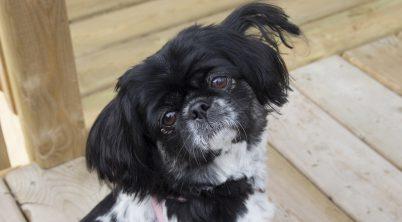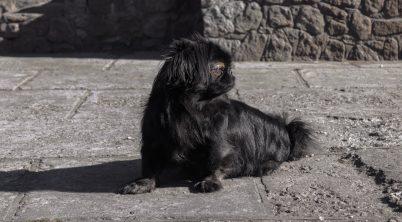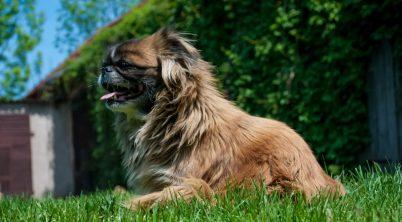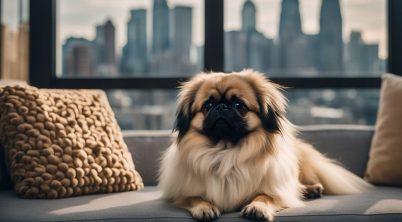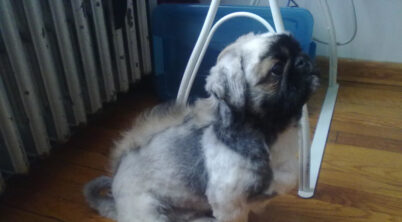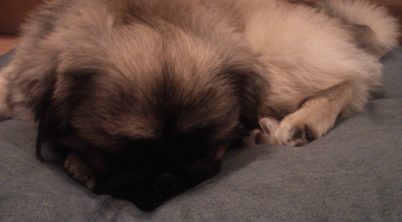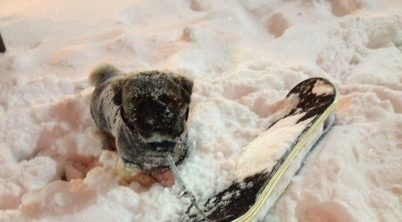The Pekingese, an ancient Chinese breed, carries a distinctive physical characteristic in its body length. This small but dignified dog has a compact body that is longer than it is tall, contributing to its unique appearance. The breed standard specifies the body length, which contributes significantly to the Pekingese silhouette—an important aspect of the breed’s conformation according to the American Kennel Club.
Generally, a Pekingese has a body length that ranges from 6 to 9 inches at the withers, with a proportionately significant length compared to its height. This elongated body is supported by short, muscular legs, which is another breed hallmark. Pekingese owners and breeders place great emphasis on these physical standards, as they are critical for show dogs and also contribute to the breed’s overall health and wellbeing.
Table of Contents
Pekingese Length Measurement
Measuring the length of a Pekingese is a straightforward process that reveals the breed’s characteristic proportions. When measuring, one goes from the chest to the base of the tail to capture the accurate body length. They should note that the Pekingese typically exhibits a slightly elongated appearance compared to its height due to the breed’s unique body structure.
Key Dimensions:
- Body Length: The distance from the chest to the base of the tail is generally greater than the dog’s height at the withers.
Table of Exceptional Proportions:
| Relative Proportion | Description |
|---|---|
| 3:5 | Height to Body Length Ratio |
The breed standard, as outlined by kennel clubs and breed specific guidelines, indicates specific values for the length of these dogs. The Pekingese’s body length should fit into a well-balanced ratio that maintains the dog’s distinct shape and silhouette.
Essential Measurements:
- Withers to Tail Base: Measured in inches for accuracy.
- Typical Proportions: The body length of the Pekingese is part of what gives the breed its trademark appearance.
It is important for owners to recognize that these numbers are averages and individual dogs may vary. Factors such as genetics and individual growth patterns can affect the precise length of a Pekingese. Handlers and fanciers should take care when measuring to ensure the dog is standing straight and naturally, without crouching or stretching, for the most accurate measurement.
Pekingese Length Age
When discussing the length of Pekingese dogs, it’s essential to understand how their size changes as they age. The growth of a Pekingese puppy to adulthood follows a general pattern.
Birth to 2 Weeks: Newborn Pekingese puppies are tiny in length, often fitting comfortably in the palm of a hand. During this early phase, they spend most of their time sleeping and feeding, growing incrementally each day.
3 Weeks to 2 Months: At around three weeks, Pekingese puppies start to be more active and with this activity comes a noticeable increase in both length and weight.
3 to 6 Months: This is a rapid growth period for Pekingese puppies. Their length increases quickly, and by the end of this period, they will have reached a significant portion of their adult length.
6 Months to 1 Year: Growth in length slows down; they start filling out rather than getting much longer. By about 1 year, Pekingese are close to their adult length.
1 Year and Beyond: By this age, Pekingese should be at their full adult length, typically ranging between 6-9 inches tall at the shoulder. They don’t generally grow in length past the 1-year mark, but they may become more muscular and stocky.
Owners should measure their Pekingese length from the shoulder to the base of the tail to track growth accurately. Genetic factors and overall health can affect the exact length at each stage.
Health and Lifespan
The Pekingese breed typically has a lifespan of 12 to 14 years. Achieving this age expectancy hinges on multiple factors, including genetics, consistent healthcare, suitable diets, and the environment in which they live. To maintain their health, Pekingese require regular veterinary care which helps in early detection and treatment of breed-specific health issues.
Pekingese are prone to several health problems. Issues such as eye and heart conditions are common within the breed. Given their short muzzle, Pekingese often suffer from brachycephalic syndrome, which can lead to breathing problems. Their long backs make them susceptible to back problems like intervertebral disc disease. Moreover, patellar luxation is a common orthopedic issue observed in this breed. The skin folds of the Pekingese require careful grooming to prevent skin fold dermatitis, and they are at risk for mitral valve disease, which affects the heart.
Proper care for a Pekingese includes regular grooming to manage their amount of shedding and to keep their skin folds clean to avoid dermatitis. Their exercise requirements are moderate; however, due to potential breathing issues, it is crucial to monitor their exercise to prevent overexertion.
| Health Aspect | Consideration for Pekingese |
|---|---|
| Breathing Problems | Monitor during exercise; be cautious in hot or humid weather. |
| Eye Conditions and Heart Issues | Regular check-ups for early detection and treatment. |
| Back Problems and Patellar Luxation | Avoid excessive jumping and rough play. |
| Skin Care | Regular grooming to maintain skin fold health. |
In essence, careful monitoring, routine healthcare, and a regulated lifestyle can help a Pekingese live a full and healthy life.
Living with a Pekingese
Living with a Pekingese offers a unique experience characterized by the breed’s noble past and distinct physical features. These dogs are well-suited to apartment living due to their compact size, but potential owners should understand the breed’s specific needs.
The Pekingese have a flat face, or brachycephalic structure, which makes them sensitive to hot weather. Therefore, it’s crucial to provide a cool environment and monitor them closely during warm seasons to prevent overheating.
When it comes to exercise, Pekingese dogs require moderate activity to maintain their health. Their exercise requirements are not extensive; daily walks and play sessions will suffice. Exercise should be tailored to their unique rolling gait, and their stocky build means that activities should not be too strenuous.
Due to the Pekingese’s physical characteristics, owners should ensure:
| Considerations | Description |
|---|---|
| Physical Activity | Short, gentle walks and indoor play to cater to their exercise needs without excessive strain. |
| Temperature Control | Air conditioning and shade during hot weather to prevent respiratory distress. |
| Facial Care | Regular cleaning of facial folds to avoid irritation or infection due to their brachycephalic nature. |
In summary, ensuring a Pekingese’s well-being involves a balance of comfortable living conditions, measured physical activity, and attentive care to their unique physical traits. Owners who can provide this will find a loving and dignified companion in their Pekingese.
Breed Specifics
The Pekingese, affectionately known as the “Lion Dog,” is a toy dog breed that holds a storied history dating back to ancient China. Recognized by the American Kennel Club (AKC), this breed exhibits a notable lion-like appearance, characterized by a lush mane of fur that demands attention.
Size:
- Height: 6-8 inches at the shoulder
- Weight: Up to 14 pounds (Dogs exceeding this weight are disqualified in AKC conformation shows)
Physical Attributes:
- Fur: Thick and abundant, it can present in various colors including fawn, delivering a regal and robust image.
- Snout: Short snout, a distinctive feature of brachycephalic breeds, making them prone to respiratory issues.
- Overall Appearance: Stocky and muscular despite its small stature, the Pekingese is built with dignity and a certain self-importance.
Health Considerations:
- Prone to brachycephalic syndrome due to their snout length.
- Potential owners should consult with a reputable breeder to understand health clearances and potential breed-specific concerns.
Historical Tidbit: The breed’s royal status traces back to the Summer Palace, where during the Second Opium War, a Pekingese known as “Looty” was discovered and subsequently gifted to Queen Victoria, making its way into Western dog fanciers’ circles.
Companionship:
- Despite their small size, the Pekingese carries a bold and vigilant attitude, often serving as a sharp little watchdog.
- This breed’s natural nobility sometimes translates into an aloof demeanor, but it is capable of affectionate bonds and will enthusiastically engage in play when the mood strikes.
It is imperative for would-be owners to understand the breed-specific needs of the Pekingese to ensure a harmonious life with these canine companions of historical grandeur.
Pekingese Care
Grooming Needs: The Pekingese boasts a long, coarse, and double coat that requires regular grooming to stay clean and healthy. They experience a moderate amount of shedding. Owners should brush the coat several times a week to prevent matting and manage shedding.
- Daily: Quickly check for debris or tangles.
- Weekly: A thorough brush-out is recommended.
- Seasonally: They may need additional grooming during shedding seasons.
Eye Care: With prominent eyes, Pekingese are prone to eye issues. Keeping the eyes clean and monitoring for any signs of irritation or infection is essential.
- Routine: Gentle wiping of the eye area can prevent buildup and check for abnormalities.
Health Concerns: Pekingese can suffer from specific health concerns like progressive retinal atrophy, affecting vision, and patellar luxation, which impacts the knees. Regular veterinary check-ups can screen for these conditions and ensure timely treatment.
- Progressive Retinal Atrophy: Schedule regular eye exams.
- Patellar Luxation: Be alert for signs of limping or discomfort.
Exercise: These dogs require moderate exercise to maintain their health. Two short walks per day or playtime in a secure area can suffice.
| Activity | Frequency |
|---|---|
| Short walks | Twice daily |
| Play sessions | As needed |
| Obedience trials | Occasionally |
Remember, a consistent care routine is crucial for the Pekingese’s overall health, combining grooming, exercise, and proactive health checks.
Pekingese as Companions
The Pekingese breed is steeped in a rich history as an esteemed companion. Traditionally associated with Chinese nobility, these dogs are known for their affectionate and loyal nature, making them excellent family companions. Their long-standing role as a lap dog to the aristocracy has imbued the Pekingese with a sophisticated demeanor.
Attributes of the Pekingese as Companions:
- Affectionate: They form strong bonds and thrive on attention from their human counterparts.
- Loyal: Their devotion to their family is unwavering, often becoming quite protective.
- Socialization: Introducing a variety of people early on is crucial for their friendly temperament.
Owners should note that while Pekingeses are not overly energetic, they do require adequate socialization to become well-rounded pets. This breed can be friendly when accustomed to different people and environments—early exposure to these is beneficial.
As family dogs, Pekingeses are better suited to homes with older children who understand the importance of gentle interaction. Their need for companionship means they prefer not to be left alone for long periods. These canines flourish in an environment where they can enjoy the company of their human family.
A unique aspect of the Pekingese is their sophisticated bearing—this is not just a dog but a long-time symbol of heritage and companionship. Embodying regal grace, a Pekingese enjoys being the center of attention and reciprocates with affection and loyalty to their caretakers.

